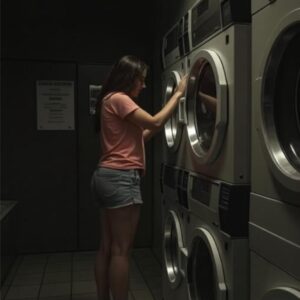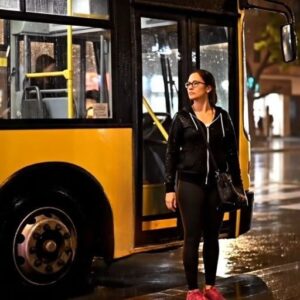The call came in as another standard report—a deserted pup trembling behind a garbage bin. When the control center mentioned it, Officer Marcus Hayes sighed deeply. He had already dealt with civilian disputes and small thefts for ten straight hours, so an animal rescue mission was the final task he wanted. But instructions had to be followed.
Marcus anticipated what he would find in the dimly lit back street off 5th Street: a scared, helpless creature left on its own. The downpour had started again, changing the narrow path into a hazardous course of puddles and waste. With his torch, he spotted the little figure crouched against the brick surface through the darkness.
Something shifted inside him when he lifted the tiny canine, barely fitting in his palms. A soft-crying dog in a torn blue garment pressed against his torso. Dread turned into confidence. Solace replaced doubt.
Marcus exhaled, holding the dog close. In his twelve years of service, he witnessed events that toughened people. Drug raids gone badly, car crashes that disturbed his sleep, and home violence that made him question human goodness. But this? His emotions softened like they hadn’t since his child’s arrival 15 years before.
He contacted the base about his discovery, but as he looked at the dog in his arms, he was already deciding, his speech unsteady. “Officer Hayes to control. I have the dog. The pet is coming to my house.”
Marcus ignored the shocked radio talk at the station. The way those large brown eyes looked at him, still hopeful despite its state, reminded him why he became a police officer: to create change, however small.
As he dried the cold bundle in his arms, Marcus faced questions from his teammates at the station. Detective Ramirez looked surprised as she watched Hayes cover the dog with his extra uniform shirt. “You know, taking in lost animals isn’t part of our job details.”
Marcus said, “I know,” surprising himself with his sureness. “Just look at her. Someone needs to give her a chance.” He gazed at his fellow officers. “Isn’t that what we should do? Offer people (or animals) new starts?”
After working with Animal Control and checking with the vet, Marcus became the happy owner of Hope, a mixed-breed puppy, the next day. She awoke something in him, so the name matched perfectly. Elena saw the puppy and wept, thankfully happy tears, before hugging her husband and their new family member.
Hope quickly became part of the family, especially with Marcus’s teen daughter Sofia. Within weeks, the timid puppy grew into a bold friend who followed Marcus everywhere. She even joined him during work shifts, sitting next to him in the police car and becoming famous in the area.
But not all residents shared the local enthusiasm. Mrs. Thompson, who led the neighborhood group, watched changes with growing dislike. Her perfectly cut bushes and grass showed her desire for structure and power in their suburban area. She chose to respond after seeing images of Officer Hayes working with a dog in the local paper.
“Completely unacceptable,” she declared at the next neighborhood gathering, throwing the newspaper onto the table. “This ‘community policing’ goes too far. Homeless animals should not roam our roads or sit in police vehicles!” Many homeowners heard her remarks, particularly those who valued tidy yards over helpful officers. They created a petition to prevent Officer Hayes from taking his dog to duty. Marcus faced possible punishment after someone sent an unknown complaint to the police leader.
Marcus needed to make his hardest job choice between following his heart and obeying department guidelines. He noticed the strange situation—he, a respected officer known for his fairness, might lose his job because of a dog that had created more positive feelings in the town than any official campaign.
Marcus observed something unusual during his shifts as stress grew. People who had previously ignored him now greeted him happily, asking about Hope and telling him how seeing the cheerful pair had improved their day. Shops noted more customers as people deliberately walked certain routes to meet the famous police dog. Teenagers who typically stayed away from police would come close to stroke Hope, starting talks they might have avoided before.
A young boy came to Marcus’ car window on a damp afternoon while he read the increasing pile of letters supporting his work with Hope in his vehicle. “Excuse me, Officer,” the boy said quietly, “but my mother wanted me to hand you this.” He passed over a handwritten message: “Thank you for showing our neighborhood that kindness counts. Hope shows us what can happen when compassion beats rules.”
The words touched Marcus deeply. Instead of heading home, he drove to the local park where families gathered that evening. From a seat with Hope, he watched parents push children on swings and older couples stroll along the paths. He formed a plan to address Mrs. Thompson’s worries while keeping Hope’s positive effect on the area.
Marcus presented a proposal to the police chief and local organization the next week. Instead of unofficial patrols, he suggested a Hope-centered Community Connection Program. Regular stops at schools, retirement homes, and public centers plus planned neighborhood walks would let citizens meet the officer and dog in controlled, safe settings.
Mrs. Thompson refused at first, but Marcus invited her to watch one of these meetings, which had a surprising result. She witnessed Hope help a silent dementia patient smile for the first time in months at the nearby senior home. Another tough person cried as Hope reminded him of his lost puppy. Even Mrs. Thompson’s strictness disappeared by the end of the visit.
The program expanded beyond expectations within months. More police joined, bringing their own dogs or working with therapy animals. The neighborhood group, now led by a kinder Mrs. Thompson, organized money-raising events for the project. Local shops gave supplies, and a nearby animal clinic offered free health checks for participating pets.
Hope gained much popularity, leading to similar programs in surrounding towns. Perhaps most importantly, the initiative built confidence and dialogue between police officers and the citizens they protected, a goal that standard police work had struggled with for years. People felt more comfortable reporting odd behaviors to officers, which reduced crime levels.
Marcus realized that Hope showed him about duty and bonding more than what he did for Hope that sad night behind the garbage bin. At times the smallest acts of kindness create the biggest results. The left-behind puppy who captured his heart transformed a neighborhood’s understanding of protection and service.
Share this tale if it affected you like Hope influenced her community. Help spread the idea that kindness is our greatest tool for creating good changes. Please tell your story of how an unexpected kind deed changed a situation in the comments below.




